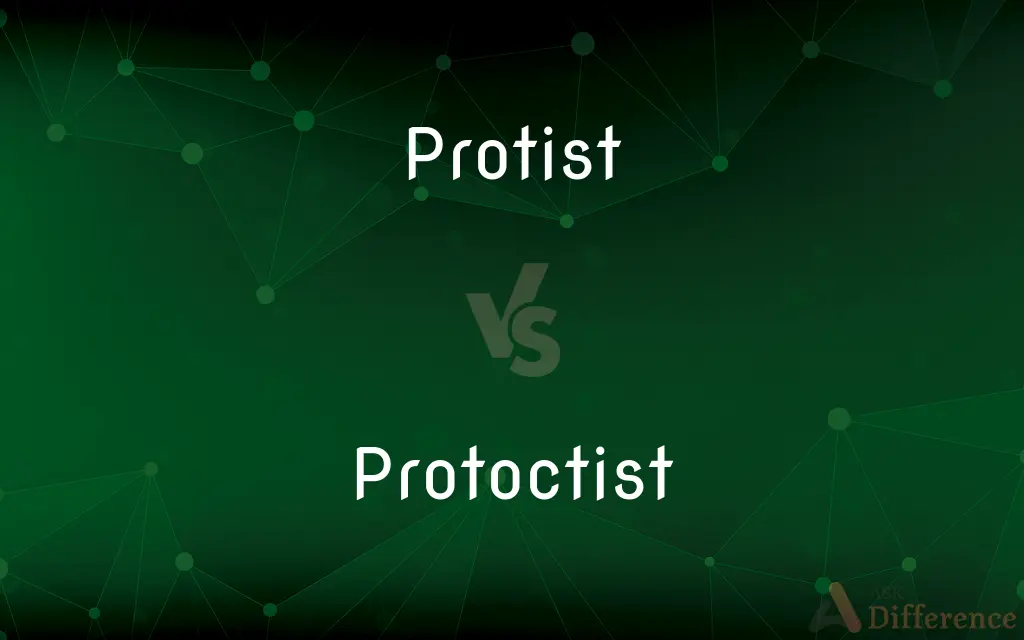Protist vs. Protoctist — What's the Difference?
By Tayyaba Rehman & Maham Liaqat — Updated on April 2, 2024
Protists are a diverse group of eukaryotic organisms, often single-celled, distinct from plants, animals, and fungi, while protoctists refer to essentially the same group but under a less commonly used term.

Difference Between Protist and Protoctist
Table of Contents
ADVERTISEMENT
Key Differences
Protists encompass a wide variety of organisms, including algae, amoebas, and slime molds, characterized by their eukaryotic cell structure, which means they have a nucleus and other organelles enclosed within membranes. These organisms can be found in almost every environment on Earth, thriving in soil, water, and as parasites in other organisms. On the other hand, protoctists represent the same broad category of life forms, but the term "protoctist" is less frequently used in modern biological classifications and discussions.
The classification of protists has been a challenge due to their immense diversity and the fact that they do not form a natural group (or clade) with a single common ancestor. Protists include both autotrophic organisms, such as algae, which perform photosynthesis, and heterotrophic organisms, like amoebas, which obtain food by ingesting other organisms. Similarly, protoctists cover the same spectrum of feeding strategies and life processes, reflecting the historical use of the term to encompass all microscopic organisms that are not bacteria, plants, animals, or fungi.
Scientifically, the term "protist" has become more prevalent and is widely accepted in the biological community, partly due to efforts to standardize the classification and nomenclature of life. The term "protoctist" is seen less frequently in contemporary scientific literature and may appear more often in historical or educational contexts where traditional classifications are discussed.
Both terms underline the challenge of categorizing a highly diverse group of organisms that do not fit neatly into the other established kingdoms of life. This difficulty in classification highlights the complexity of life and the ongoing evolution of scientific understanding and taxonomy.
Comparison Chart
Definition
Diverse group of eukaryotic organisms, often single-celled.
Essentially the same as protists; an older term.
ADVERTISEMENT
Classification
Eukaryotic, not fitting into plant, animal, or fungi kingdoms.
Identical to protists, covering a broad range of organisms.
Common Examples
Algae, amoebas, slime molds.
Same as protists, including algae and amoebas.
Feeding Strategies
Includes autotrophs (like algae) and heterotrophs (like amoebas).
Same as protists, spanning autotrophic and heterotrophic modes.
Usage
More commonly used in modern scientific literature.
Less commonly used; more historical or educational contexts.
Compare with Definitions
Protist
Eukaryotic Diversity.
Protists are diverse, ranging from the photosynthetic algae in oceans to the parasitic protozoa in animals.
Protoctist
Historical Term.
Protoctists refer to a broad category of life, including organisms like algae and slime molds, using a less common term.
Protist
Environmental Role.
Protists play key roles in ecosystems, such as algae producing oxygen through photosynthesis.
Protoctist
Educational Context.
The term protoctist might be encountered in discussions about the historical development of biological classification.
Protist
Complex Life Cycles.
Some protists, like malaria-causing Plasmodium, have complex life cycles involving multiple hosts.
Protoctist
Diverse Life Forms.
Protoctists encompass a variety of life forms, demonstrating the wide range of organisms classified outside of plants, animals, and fungi.
Protist
Non-Clade Group.
Protists do not form a natural group but are classified together for convenience due to their unique characteristics.
Protoctist
Classification Challenges.
The classification of protoctists, similar to protists, illustrates the complexities and ongoing evolution of taxonomy in biology.
Protist
Single-Celled Organisms.
Many protists, such as amoebas, are single-celled, but exhibit complex behaviors.
Protoctist
Ecosystem Importance.
Like protists, protoctists contribute significantly to environmental functions, such as nutrient cycling.
Protist
A protist () is any eukaryotic organism (that is, an organism whose cells contain a cell nucleus) that is not an animal, plant, or fungus. While it is likely that protists share a common ancestor (the last eukaryotic common ancestor), the exclusion of other eukaryotes means that protists do not form a natural group, or clade.
Protoctist
Any of several unicellular protists of the kingdom Protista (formerly Protoctista).
Protist
Any of numerous eukaryotic organisms that are not fungi, plants, or animals and are chiefly unicellular or colonial. Protists that are multicellular do not have cells differentiated into tissues. The protists include the protozoans, certain algae, oomycetes, and slime molds.
Protoctist
Any of various eukaryotic organisms belonging to the kingdom Protoctista in some classification systems. Protoctists include unicellular and multicellular organisms that are not fungi, plants, or animals. They are usually now referred to as protists.
Protist
(microbiology) Any of the eukaryotic unicellular organisms including protozoans, slime molds and some algae; historically grouped into the kingdom Protoctista.
Protoctist
Of or pertaining to these organisms.
Protist
Single-celled eukaryotes, prokaryotes and sponges
Protoctist
Any of the unicellular protists
Protist
Single-celled eukaryotes and prokaryotes
Protist
Single-celled eukaryotes
Protist
One of the Protista.
Protist
Free-living or colonial organisms with diverse nutritional and reproductive modes
Common Curiosities
What are some common environments where protists are found?
Protists thrive in almost all environments, including freshwater, marine, and terrestrial ecosystems, and as parasites.
How do protists contribute to ecological balance?
They play critical roles in nutrient cycling, form the base of food webs, and some symbiotic protists are essential for the health of coral reefs and other organisms.
Can protists cause diseases?
Yes, several protists are pathogenic to humans and other animals, such as the protozoa that cause malaria and amoebic dysentery.
Are all protists single-celled?
While many are single-celled, some protists can form colonies or multicellular organisms, showing a wide range of complexity.
What distinguishes protists from bacteria?
Protists are eukaryotic, meaning their cells contain a nucleus and organelles enclosed within membranes, unlike bacteria, which are prokaryotic and lack these structures.
Why are protists difficult to classify?
Due to their immense diversity and lack of a single common ancestor, making them a paraphyletic group.
Why are protists important in food webs?
They often serve as primary producers (like photosynthetic algae) or as primary consumers, feeding on bacteria and other microorganisms, thus sustaining higher trophic levels.
Why has the term "protoctist" fallen out of favor?
The scientific community has largely standardized on the term "protist" to refer to these organisms, reflecting a move towards clearer and more consistent classification.
How do protists reproduce?
Reproduction can be by both ways, varying greatly among different protist species, with some undergoing complex life cycles.
Do protists have a role in human industry or research?
Yes, some protists, like certain algae, are used in biofuel production, wastewater treatment, and as model organisms in genetic and medical research.
Share Your Discovery

Previous Comparison
Delay vs. Cancel
Next Comparison
Definition vs. SpecificationAuthor Spotlight
Written by
Tayyaba RehmanTayyaba Rehman is a distinguished writer, currently serving as a primary contributor to askdifference.com. As a researcher in semantics and etymology, Tayyaba's passion for the complexity of languages and their distinctions has found a perfect home on the platform. Tayyaba delves into the intricacies of language, distinguishing between commonly confused words and phrases, thereby providing clarity for readers worldwide.
Co-written by
Maham Liaqat














































